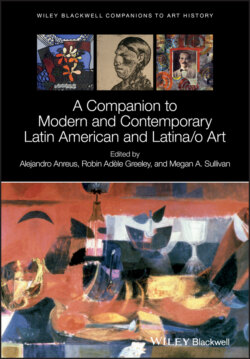Читать книгу A Companion to Modern and Contemporary Latin American and Latina/o Art - Группа авторов - Страница 24
1.2.3 David Alfaro Siqueiros
ОглавлениеThe most vehemently political of these three painters was Siqueiros. He was committed to the theory that for each period of art, the political content of the artwork be progressive but also that the materials and techniques should be the most advanced possible. Such insistence on modernity in content and in materials would guarantee that art of political conscience would not slip back into outmoded principles. Thus, he moved away from conventional symbolism in his topics and from fresco in his technique and toward contemporary topics such as the organization of the Mexican working class and toward techniques such as electrical spray machines.
In 1923 the Syndicate of Technical Workers, Painters, and Sculptors was formed. The Manifesto of the syndicate, written mostly by Siqueiros and signed by Rivera and Orozco among others, is marked by language taken from radical workers' groups and instantly gave a sharp political edge to the activities and artwork of its members.4
The Manifesto attacks “bourgeois individualism.” Easel painting is aristocratic, to be replaced by “the monumental expression of art because such art is public property.” A crucial paragraph reads: “We proclaim that this being a moment of social transition from a decrepit to a new order, … our supreme objective in art … is to create something of beauty for all, beauty that enlightens and stirs to struggle” (Anreus et al. 2012, p. 320). This sort of discourse would inform Siqueiros' words, actions, and art throughout his career.
Retrato de la burguesía (Portrait of the Bourgeoisie), painted by a team headed by Siqueiros, is an intense, highly dramatic burst of political rhetoric by an artist committed to exposing the dangers of the growing threat of fascism (illustrated in Folgarait 1998, plates XIV–XVII; Rodríguez 1969, pp. 361–362; and Rochfort 1963, pp. 153–158), covering three walls and the ceiling of a stairwell at the headquarters building of the Mexican Electricians' Syndicate in Mexico City. Painted in 1939, at the very height of the tensions leading to World War II, the images warn of international conspiracies on the part of both the Western democracies and their fascist enemies to exploit and butcher workers and the helpless masses for the sake of increasing their wealth and power. We see the lynching of a black man, a peasant mother huddling with her child, countless troops marching to war, a metallic war vulture hovering, a huge machine pumping out gold coins, and cartoon‐like men representing the great world powers about to go to war. A large figure dominates the left wall (illustrated in Rodríguez 1969, p. 361, and Rochfort 1993, p. 156). It is a grotesque hybrid of animal, human, and machine. The trunk of a man flails its arms wildly, so much that they leave motion traces in the air to suggest a manic animation. The head is that of a parrot, swiveling so forcefully that we see two stop‐action positions. A microphone broadcasts his message to a seething mass marching below his perch. By this monstrous creation Siqueiros meant to depict a fascist dictator. The mass slowly forms into regimented ranks, eventually becoming German soldiers advancing in formation.
Siqueiros, during the execution of this mural, was living a life as politically charged and dramatic as is this imagery. A devoted Stalinist, he took direct action against Stalin's archenemy, Leon Trotsky, who was exiled in Mexico City to escape Stalin's assassins. Siqueiros organized and carried out a terrorist act against Trotsky, leading a band of gunmen who left multiple machine‐gun bullet holes inside the Trotsky residence. I recount this act to impress upon the reader that art and politics were not seen as distinct areas of social behavior by Siqueiros and that he believed in fully carrying out the mission of his political beliefs, attacking his enemies with paint and with bullets.
